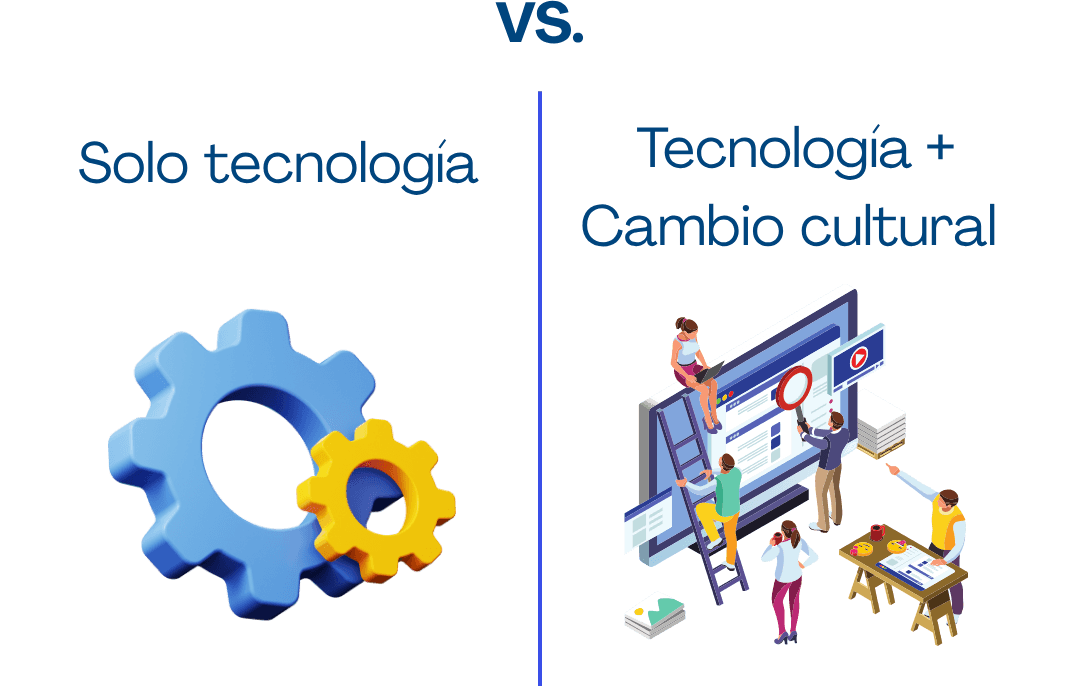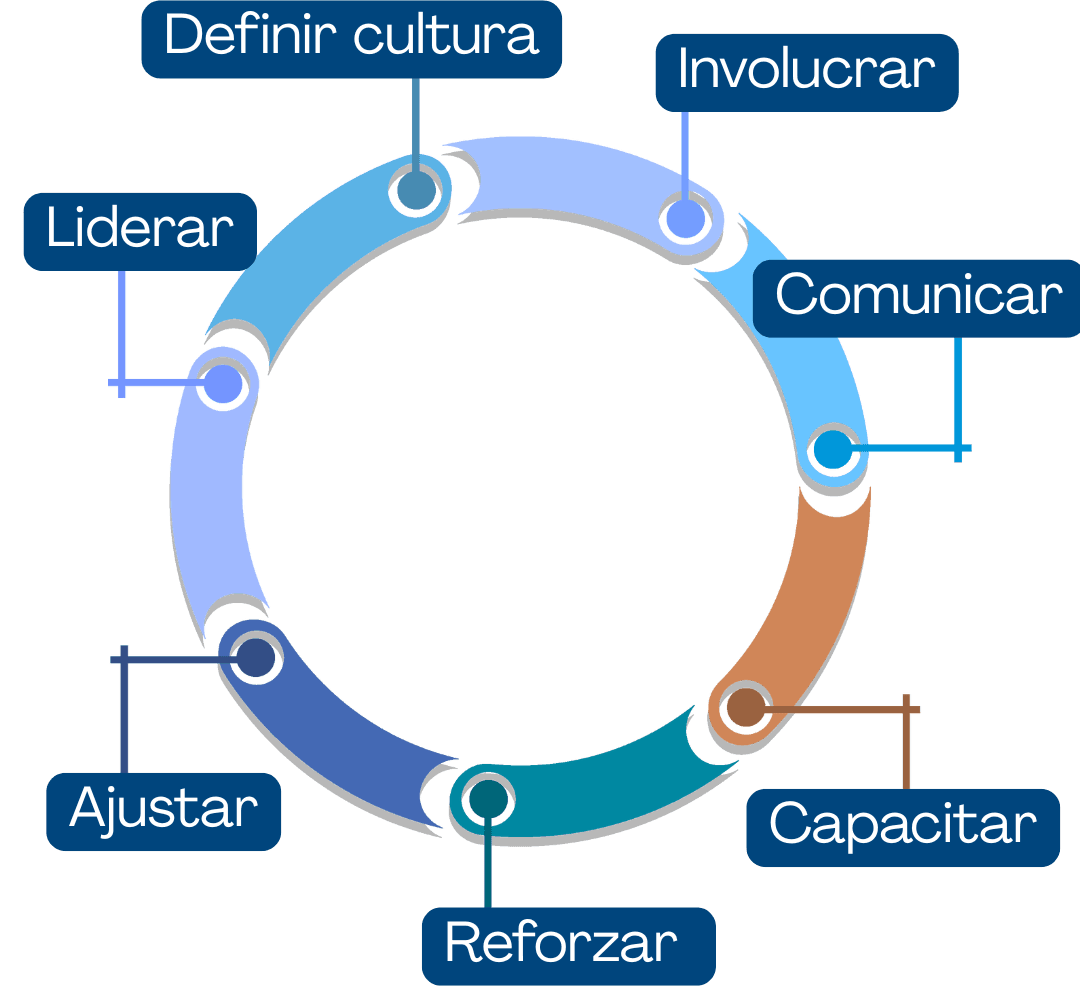Cultural change: the hidden key to profitable digital transformation
Discover how a strong cultural shift drives digital transformation, increases productivity, and strengthens business competitiveness.
Are you about to embark on a digital transformation journey? Prepare yourself: it's not just about technology. It's about how you, your team, and your entire organization optimize your business model and processes to compete in a digital B2B marketplace. Understanding cultural change is critical to a successful digital transformation. It's like learning a new language. It's not simply about swapping old tools for new ones, but about changing the way you communicate, work, and think. Let's delve into the heart of digital transformation: cultural change. Let's explore how it affects your organization and why it's key to achieving a successful digital future.

Image created by Avantech using graphic elements from Canva.com.
The importance of cultural change in digital transformation
Understanding the link between digital transformation and cultural change is not as simple as it seems at first glance. Remember that comprehensive digitalization is not simply the adoption of a new technology, but a radical paradigm shift that introduces significant changes to an organization's operations and affects everything from communication to workflows, directly impacting operational efficiency and ROI in sectors such as mining, energy, manufacturing, and corporate services. Consider the case of digital transformation culture, which involves creating an environment where innovation thrives, everyone feels comfortable with digital tools, and the organization readily accepts change. In such an environment, experimentation becomes common practice, fostering a culture receptive to change and enhanced by digital solutions, rather than wary of new technologies.
If we delve deeper into digital cultural change, we will discover that it is linked to the organization's people and their ability to use digital resources, adapt, and innovate. For example, employees must value the benefits offered by digital processes. They must be willing to change old routines for new ones, improving efficiency and increasing productivity.
It is essential to understand that digital transformation is a concept embedded in the organization's culture. It is not simply about replacing analog systems with digital ones. It is a cultural restructuring in which all team members, from the From executives to practitioners, everyone appreciates the benefits that this cultural shift can bring.
Understanding how these two areas (digital transformation and cultural change) interrelate allows us to grasp the magnitude of the transformation. By identifying the importance of cultural change within digital transformation, organizations can develop a solid strategy to change the very spirit of the organization. This realization fosters a digital-friendly environment in which everyone participates in the change, ensuring a smoother transition into the digital age (https://gerens.pe/blog/transformacion-digital-y-madurez-tecnologica-de-la-empresa).
Remember that, on the path to a digital future, technology is simply the cutting-edge tool that helps us get there. The true driving force behind successful comprehensive digitalization lies in cultural change—in people embracing and leading change rather than following it. It's an exciting journey, fraught with challenges but full of opportunities waiting to be seized. Therefore, when planning the path to becoming As a digital organization, keep in mind that cultural change holds the key to successful transformation.
Is your organization ready to challenge its traditional processes and adopt a digital work model at all levels?
Cultural change: Key to the digital transformation of companies
Digital transformation isn't just about introducing new technologies into your company. It involves radically changing a company's culture. This progressive change reaches down to the very core of the company and affects how it communicates, performs tasks, and solves problems. It's safe to say that, when embarking on the digital modernization journey, merely implementing digital tools or technologies would be a half-measure.
For companies, a fundamental component of digital transformation centers on the workforce. Like the blood that runs through our veins, employees are the lifeblood of an organization. Without their buy-in, comprehensive digitalization can end in a sea of resistance and inertia. Therefore, digital cultural change is of immense importance, on par with technological upgrades.
A digital organizational culture fosters an environment of innovation and facilitates business digital adoption, which is key to competitiveness in B2B environments. This culture doesn't implement digital tools reluctantly, but rather views them as valuable assets. At the same time, it encourages your staff members to adopt a digital approach, generating efficiency gains in your operations.
Furthermore, a digital transformation culture fosters learning. Employees are encouraged to strengthen their digital skills, enabling them to navigate the digital landscape with confidence. These individuals begin to appreciate the potential and benefits of new digital processes and routines, which, in turn, strengthens their commitment to your company's digitalization initiative.
Ultimately, to achieve a successful digital transformation, your organization's culture must take a similar leap. It's less of a challenge and more of a metamorphosis into a digital butterfly. And remember, a half-hearted digital transformation will yield diluted benefits. Therefore, aim for a comprehensive digital cultural change. Enable your entire company's operations to communicate digitally. The result? A streamlined and efficient organization, at the forefront of digital adoption and resilience.
Implementing a cultural change for a successful digital transformation
Initiating a cultural change in an organization geared toward digital transformation isn't something that can be achieved overnight. It requires a strategic plan, clear communication, and the flexibility to evolve as needed. Below are the main steps.
- Identify and define the new culture: Understand what a digital transformation culture means for your organization. Does it mean becoming more agile, fostering continuous innovation, or adopting a "fault-tolerant" approach? Recognize and define the characteristics of the culture you want to foster.
- Involve all levels of the organization: From board members to entry-level employees, everyone must participate in the cultural change. This inclusion fosters a sense of belonging and acceptance at all levels.
- Establish clear and consistent communication: Transparent and regular communication is critical to implementing a cultural change. Use your internal communication channels to convey the vision and progress of the change, maintaining a dialogue with your team.
- Promote digital skills and education: Equip your staff with the skills necessary for comprehensive digitalization, aligned with the business's digital strategy. Offer training and educational resources to encourage continuous digital learning.
- Provide positive reinforcement: Reinforce new behaviors and values that are critical to digital modernization. Recognize and reward those who lead by example and promote a culture of digital leadership.
- Make adjustments: Recognize that cultural change doesn't happen all at once. Review, measure, and adjust your approach over time. Use feedback from your staff to guide modifications.
- Lead by example: Leaders play a critical role in implementing cultural change. You must provide concrete examples of the mindset, behaviors, and values of the desired digital transformation culture.

Image created by Avantech using graphic elements from Canva.com.
As you implement these steps, remember to be patient and persistent. A comprehensive digital culture shift won't happen instantly, but with consistent effort, you'll gradually see a shift in your organization's DNA toward adopting and developing a digital transformation culture.
Success stories: companies that achieved digital transformation with a cultural change
If you delve into the depths of digital transformation, you'll find real stories of companies that achieved success by instilling a digital culture. We showcase the journeys of two such companies.
- DBS Bank. DBS Bank boosted its digital transformation by fostering a digital culture through internal training, programs like DigiBootcamp, and a startup mindset, earning it the World's Best Digital Bank award in 2019.
- Microsoft. Microsoft, for its part, revitalized its corporate culture by adopting a growth mindset and promoting collaboration through an open source culture, which boosted its innovation, integration with other platforms, and market relevance.
Which practices from these companies could you adapt to boost digital culture in your own industry?
Leadership and Cultural Change: Strategies for a Strong Digital Transformation
To enter the realm of digital transformation, cutting-edge leaders committed to fostering a digital culture are needed. It's important to note that business leaders play a crucial role in cultural change within digital transformation. Their strategies and actions influence this digital cultural shift at various levels of an organization.
- Define a clear vision and strategy: As a leader, establish a clear vision for digital transformation and align it with a comprehensive strategy. This vision requires broad commitment that is directly reflected in business objectives and customer experience goals.
- Foster digital literacy: Promote the proliferation of digital literacy in every corner of the organization. This step involves training staff in new digital paradigms, emphasizing business processes instead.
- Lead with empathy: Digital transformation can generate anxiety among employees. Counter this problem with empathy, facilitating an enabling environment for your team to understand new technologies and workflows.
- Encourage collaboration and innovation: Promote a workplace that encourages collaboration and rewards innovation. Open cross-departmental discussions can lead to creative problem-solving techniques and act as a catalyst for your digital modernization culture.
- Empower teams: Empower your team members with decision-making capabilities. The autonomy to take calculated risks helps foster a culture of innovation and agility.
- Communicate regularly: Transparent communication plays a critical role. Regularly announce progress, changes, learnings, and results. This sharing helps create an informed and united workforce.
- Embrace agile practices: Embrace agility. Responding quickly to changes and learning from mistakes, not only in theory but also in practice, pave the way for a dynamic digital culture.
- Measure performance: Track the impact of changes. Use relevant metrics to measure success, progress, and areas for improvement.
Leaders are the spearhead of digital transformation, as they shape values, set the pace, and make decisive contributions to cultural change. They can foster a culture of digital transformation that encourages innovation, promotes digital literacy, and fosters empathy. By adopting these suggested strategic steps, you, as a leader, could foster an effective digital transformation in your organization.
Main challenges in cultural change for digital transformation
As your company embarks on the cultural change journey for digital transformation, it faces multiple obstacles. Understanding these obstacles allows your management to develop solid strategies to avoid potential setbacks.
Three main challenges prevent a smooth digital cultural change.
Resistance to change:** Change, even if it's for the better, often generates apprehension and resistance from employees accustomed to proven workflows and methodologies. To counter this, promote participation in your digital cultural change agenda. Involve your workforce in decision-making processes and offer them a sense of ownership over this digital change.
Lack of digital literacy among employees:** As technologies evolve rapidly, keeping up with new tools and technologies can be overwhelming. Invest in training and development for your workforce. Provide adequate resources for employees to learn and adapt to the new digital landscape.
Limited resources and funding: Adopting digital transformation often requires a significant financial investment, which can be a challenge for small and medium-sized businesses. To combat this obstacle, try leveraging cost-effective technologies and solutions. Seek out partnerships and collaborations. After all, digital transformation doesn't equate to the most expensive technology, but the most effective!
Addressing these challenges early contributes to a smooth digital transformation cultural shift. Remember that creating a digitally fluent culture within your organization doesn't happen overnight; it's a transformative process. Therefore, expect obstacles, prepare for them, and persevere.

Image created by Avantech using graphic elements from Canva.com.
Conclusion: Why does cultural change define the success of digital transformation?
You've already seen how vital a cultural shift is on the path to digital transformation. It's not just about integrating new technologies, but also about restructuring communication, workflows, and fostering a culture of innovation. As a leader, your role is critical in promoting digital literacy, empathy, and collaboration within your team. Yes, challenges such as resistance to change and limited resources may arise, but remember that with the right strategies, such as promoting engagement and investing in employee training, these obstacles can be overcome. It's about starting early, addressing these challenges head-on, and leading your organization toward digital fluency, maximizing its competitiveness and profitability in the B2B ecosystem. Embrace this change and lead your team toward a successful digital transformation.
This article was originally published in Digital Transformation Company in the UK. It was translated and published by GĚRENS in December 2024. Learn more about the latest in the industry with our Global MBA STEM and stand out in the industry.
Digitalization Innovation Technology Transformation Digital Transformation in Mining
Previous
An Outstanding Achievement: Dr. Vinio Floris Honored with the AAEES Koppe Lecturer Award
Next
Fiscal Bailouts and the Petroperú Crisis
Related Articles
Economy and FinanceEVAPROMINMiningMining and EnergyMining and EnergyNewsMining Production
Mining investments in Peru exceeded US$368 million April 14, 2025
1 Minute read
Mining investments in Peru reached US$368 million in January 2025, reflecting a 26.1% increase compared to…
Economy and Finance
Lessons Learned and Mining Outlook: Discussion at GĚRENS Graduate School March 20, 2025
4 Minute read
The GĚRENS Graduate School held a discussion entitled "Mining in Peru: Lessons Learned, Challenges, and Opportunities," in which…
Economy and FinanceMiningMining and EnergyMining and EnergyTailings
Transforming ore into sand to solve a crisis March 19, 2025
5 Minute Read
Every year, the world consumes 50 billion tons of sand, gravel, and crushed stone. This is equivalent to 12.5 million…
Leave a reply
Keywords
More content
- Blogs

- Podcasts

- News

- Success Cases



